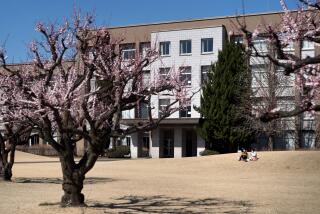Sun Is About to Set on Two Years of Economic Peace With Japan
- Share via
Before too long, a major blowup will erupt between the United States and Japan. It has been too quiet on the Eastern front for too long.
The last transpacific dustup occurred two years ago, at the height of the Asian financial flu. Washington was then declaiming that the region’s economic problems had nothing to do with mistakes by the Western financial institutions but had everything to do with Asia--especially with Japan’s failure to reform and suck up enough imports from other Asian economies to get the region back on its feet. Since then, of course, Asia as a whole has bounced back, even though many of the reforms that Washington said were required for Asian resurgence haven’t been implemented. So much for U.S. omniscience.
Before that came the furious exchange of transoceanic insults during the deep U.S. recession of the early 1990s, when the phenomenal Japanese balance-of-trade advantage was oft depicted as a cause of American woes. Today, of course, the U.S. economy is soaring despite the same huge trade deficit with Japan. Interesting, isn’t it?
The U.S. economy may well stumble this year, however, after so many months of expansion. And the Japanese are already starting to pull back on bank restructuring and other major reforms. The pullback is just beginning. With all-important parliamentary elections set for October, how many Japanese politicians will take on the many vested interests opposed to reform? And with U.S. elections in November, watch out, especially if the economy ticks downward. Japan, with its eternal trade surplus and stubbornly unchanging ways, will be too tempting a target.
There is danger that a suddenly unglued U.S.-Japan relationship would unhinge Asia, already rocked by Russia’s renewed anti-Americanism, Indonesia’s new uncertainties, the shocking nuclearization of South Asia, never-ending tensions on the Korean Peninsula, the Chinese missile buildup and the U.S. bid to drape a so-called antimissile system over the region, including Taiwan.
What’s really annoying about the recurring agony between the U.S. and Japan is that much of it is based on plain misunderstanding. Japan’s failure to open its economy and bend to U.S. ways is not a product of willful Japanese stubbornness, much less a national failure to recognize that serious changes in their economy are needed. Indeed, just such a clarion call for change, written in the prestigious Japan Times earlier this month by Kyoto University economist Takamitsu Sawa, ran under the telling headline: “A Nation Adrift.” The Japanese are well aware they are in a deep soup, but the soup is largely the well-cooked stock of their embedded culture. For instance, the infamous, intricate network of relationships and corporations known as keiretsu would enrage any red-blooded U.S. antitrust lawyer, to be sure. Yet they represent unbroken centuries of custom that can be traced back, in this instance, to the 17th century’s House of Mitsui.
Today the corporate children of the Mitsui group, which pumps out everything from noodles to missiles, rake in--even during the current recession--annual sales equal to the gross domestic product of the Russian Federation. Given such success, wouldn’t you be reluctant to change your ancient ways?
So too with the Japanese aversion to firing workers. This custom is not due to any intellectual failure to comprehend the meaning of labor costs, but to long experience with the benefits of keeping workers on payroll even during hard times. For instance, the late Konosuke Matsushita, whose empire now includes many worldwide brand names, is a legend even today in Japan because of a famous incident: In 1929, when the Depression cut his company’s sales in half and massive firings seemed the only alternative to bankruptcy, “Matsushita refused to do this,” notes journalist Mark Weston in his superb new book “The Giants of Japan.” The rest is legend: Within a few years, sales soared back to normal, and contemporary Matsushita subdivisions like Panasonic and Quasar are doing just fine. In the book’s introduction, former U.S. Ambassador to Japan Walter Mondale remarks: “It is important that Americans learn as much as they can about Japan. Even among educated Americans, I have often found a shocking ignorance. . . . Ignorance is always dangerous. But in international matters, it can lead to . . . human hatred, and even war.”
In truth, Japan and the United States have more in common than their strategic and economic interdependence. They have strikingly parallel inadequacies. Consider that the United States’ economic and social system, markedly successful until now, empowers the free market as the main arbiter of people’s fate. By contrast, Japan’s approach, until relatively recently the wonder of the world, ignores free-market ideology if it engenders unacceptable social or political consequences. The criticism of the Japanese approach is that it is not as economically efficient as the American one (true). The knock on the latter is that it yields income disparities and social inequalities that dwarf anything to be found in the former (also true).
Find a system that blends the American commitment to efficiency and the Japanese commitment to equity and you may have uncovered the long-desired Third Way. Rather than locking horns, the United States and Japan should be putting their equally stubborn heads together not only to solve their own problems, but also to offer some world leadership to others. Is that too much to ask?
More to Read
Inside the business of entertainment
The Wide Shot brings you news, analysis and insights on everything from streaming wars to production — and what it all means for the future.
You may occasionally receive promotional content from the Los Angeles Times.










